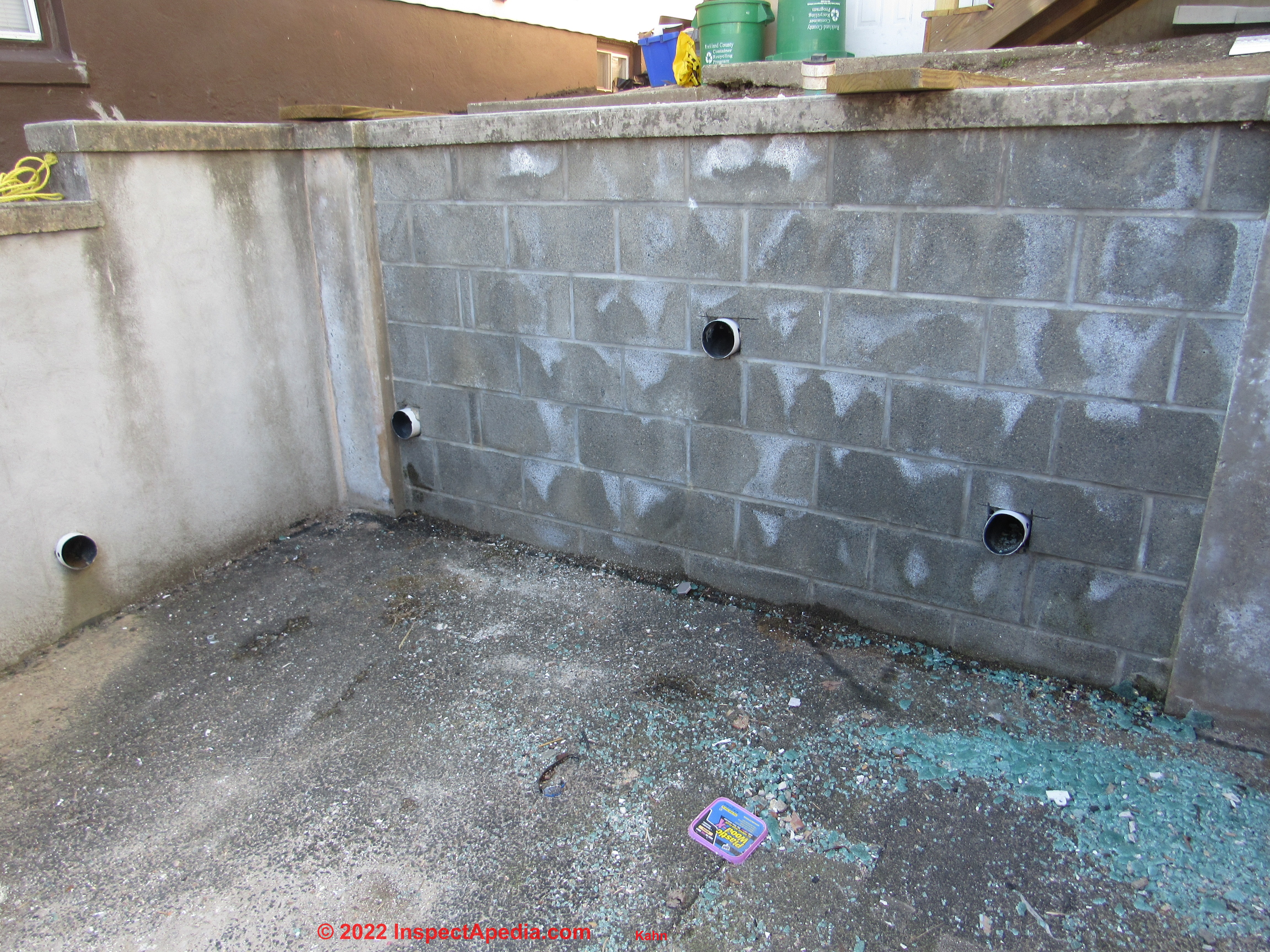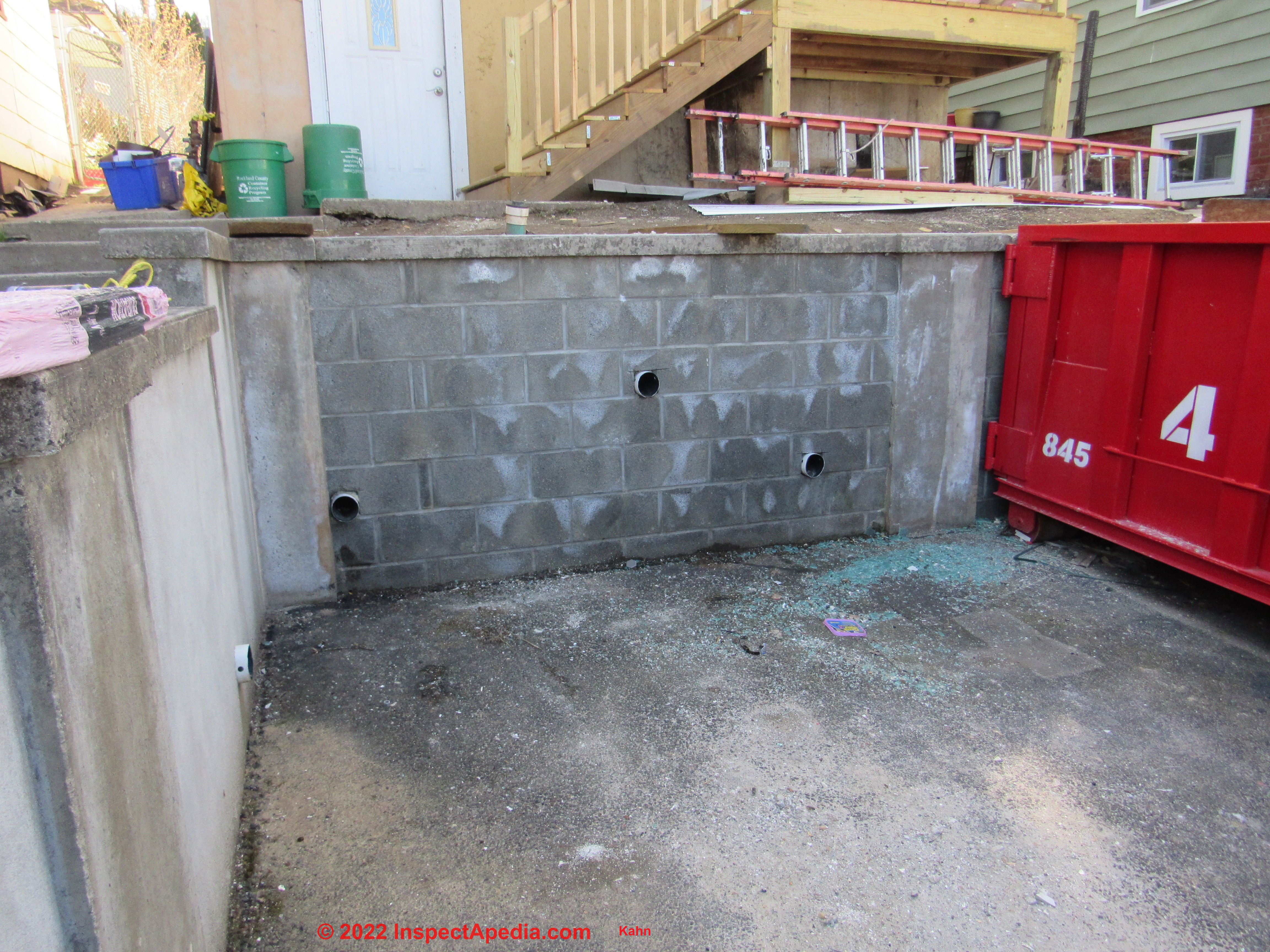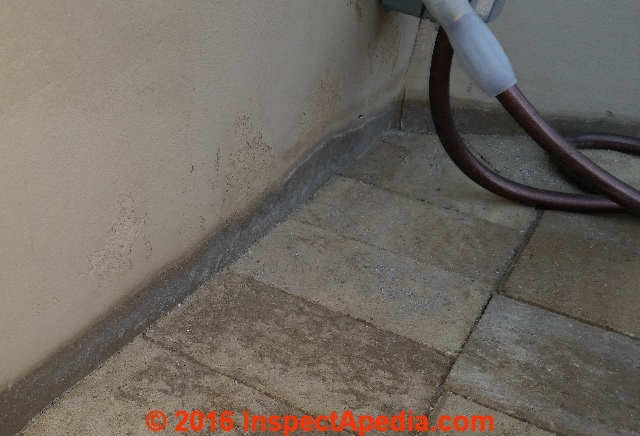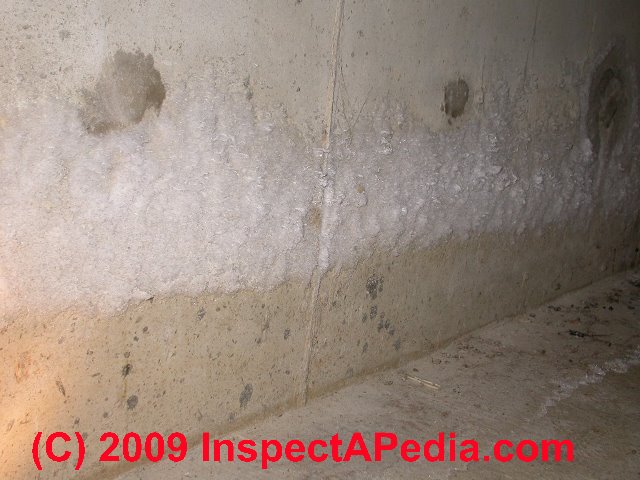 Remove & Prevent Mineral Efflorescence on Building Surfaces
Remove & Prevent Mineral Efflorescence on Building Surfaces
How to Clean Off & Prevent Efflorescence, Salt Deposits, White, Brown, Red, Other
- POST a QUESTION or COMMENT about the cause, cleanup, & prevention of brown or red stains & efflorescence deposits on building surfaces
How should you clean off or remove efflorescence, stains, or "growths" on building surfaces?
Here we describe the removal and prevention of mineral deposits, efflorescence, that forms white, red or brown stains on building interior or exterior masonry or stucco surfaces.
Invariably these crystalline salts are caused by moisture or water leaks that leach minerals out of nearby materials such as the concrete wall shown below. As the water evaporates from the surface it leaves crystallized salts like those shown.
InspectAPedia tolerates no conflicts of interest. We have no relationship with advertisers, products, or services discussed at this website.
- Daniel Friedman, Publisher/Editor/Author - See WHO ARE WE?
How to Remove & Prevent Efflorescence on Building Surfaces & Materials
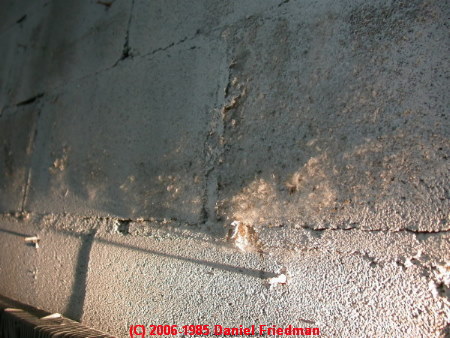 Question:
What steps should I take to remove efflorescence from my building?
Question:
What steps should I take to remove efflorescence from my building?
What steps should I do to remove the efflorescence in my building? - Valerie Mercer
Reply: Ordinary Cleaning of surfaces followed by finding and fixing the moisture source are needed
Below we summarize procedures to remove efflorescence from both indoor and outdoor building surfaces.
How to Remove Efflorescence deposits on Indoor Surfaces
You can often remove indoor mineral salt efflorescence from a surface by ordinary cleaning methods.
- Vacuum: If the surface is dry enough not to harm the equipment, I'd start by vacuuming the surface to get rid of most of the loose material.
- Wipe: Following vacuuming you can wipe the surface with a damp cloth or even use a spray household cleaner if you prefer and depending on the surface material.
Besides water, here we list cleaning agents that can remove efflorescence or other stains from masonry surfaces, roughly in order of severity and danger:
Any household cleaner, even a damp cloth wipe after vacuuming can be sufficient.
Vinegar solution can also help dissolve white efflorescence stains
Commercial masonry, stone, brick, or concrete cleaning products - follow the manufacturer's instructions. We list some example masonry cleaning products below at MASONRY CLEANERS
Oven cleaner can often remove stains from masonry.
Muriatic acid is a common but dangerous chemical often used by cleaning professionals and chimney sweeps to remove stains from masonry surfaces and chimneys.
Watch out: do not attempt to use muriatic acid nor any other harsh chemical without reading and following the manufacturer's safety advice and procedures. You can get badly burned or even lose an eye. - Dry: as we repeat ad-nauseum, if you cannot also find and fix the moisture source then the efflorescence will return.
- Patience - Repeat: you will almost always find that efflorescence will return and be cleaned off of indoor surfaces, especially floors and masonry walls that are below grade, several times before the problem goes quiet, since it can take time for moisture in masonry walls or earth against masonry walls to dry out. If the efflorescence returns as ugly as ever you may not have found the water or moisture source.
Dehumidification for efflorescence control?
You might think that indoors you could just run a dehumidifier but in my opinion that won't fix an efflorescence problem since almost always efflorescence on masonry surfaces indoors is caused by outside moisture that is penetrating the building.
Masonry sealer paints for efflorescence control?
Painting the interior side of an exposed masonry foundation wall with a masonry sealer paint will not fix an actual basement wall leak and in such cases the paint job will not be long lasting protection against efflorescence either.
However, painting the interior surface of the foundation wall with an appropriate sealer paint will slow down the passage of moisture through the wall and thus slow the formation of mineral salts in the future.
Incidentally, in our white efflorescence photo (above left), the concrete wall had been painted, but not with a masonry sealer paint. We can make that guess because masonry sealer paints typically appear thicker and more granular on the wall due to their content of portland cement and sometimes sand for added body and waterproofing.
How does the sealer paint work to help against basement moisture?
A significant factor in the movement of moisture (as opposed to an outright water leak) through a foundation wall is the combination of capillary action that moves water molecules through a substance and evaporation from the indoor wall surface that acts as a molecular pump to send that moisture into the building air.
By sealing the interior surface of the foundation wall we are significantly slowing the capillary movement of water thorough the wall by interfering with its ability to reach and evaporate into room air.
How to Remove Efflorescence deposits on outdoor surfaces
 The stains on this brick chimney are introduced
The stains on this brick chimney are introduced
On an outdoor masonry surface you can use soap and water or just plain water and a spray hose or if the surface can tolerate it, a power washer to remove efflorescence
- Brush:
gentle brushing with a soft bristle brush can knock off heavy efflorescence and make additional cleaning easier. - Wash:
gentle spraying of the masonry surface can remove additional efflorescence and staining, though adding water and really soaking the wall will probably also encourage the formation of the next generation of mineral salts that form on the masonry or stucco surface.
For this reason I prefer to keep use of liquids to a minimum. If the exterior surface is unpainted masonry I might try a little vinegar solution spray to help dissolve efflorescence and to slow its reappearance.
Watch out: take care not to blow water into the building nor damage exterior surfaces when using a power washer / sprayer.
For example, many antique brick walls use bricks whose exterior skin is hard from the firing procedure. But if your power washer (or for painters, your sand blaster) removes that hard coating from the exterior brick, the exposed soft brick will weather, leak, and deteriorate rapidly. You'll have ruined the wall.
See the general discussion of the range of masonry cleaners above where we describe cleaning indoor masonry surfaces, and also
see MASONRY CLEANERS. - Dry:
find and fix the moisture source. - Patience - Repeat:
you will almost always find that efflorescence will return and be cleaned off several times before the problem goes quiet, since it can take time for moisture in masonry walls or earth against masonry walls to dry out.
Find and fix the outside moisture source of leaks into a building interior or into a building exterior masonry component
Photo: white efflorescence on the surface of a new concrete block retaining wall in the Northeastern U.S. courtesy of home inspector Dov Ber Kahn.
Question: is this white efflorescence retaining wall OK or should the owner be worried?
The CMU retaining wall with drainage was installed at the front of the home.
The wall appeared plumb but was concerned regarding the efflorescence.
It's a new wall - the house was recently-renovated.
What are your thoughts? - DovBer Kahn
Moderator reply: diagnostic questions about the cause of masonry block retaining wall efflorescence
The absence of signs of any settlement, leaning, bulging, bowing is encouraging, but it is of course early in the life of the wall. Key, as you know, is avoiding accumulation of water behind the wall: hence those over-sized drain holes we see in the photo.
But more is needed than drain openings through a retaining wall. Besides proper construction (footing, anchors, etc. that we can't see), backfill of gravel can improve drainage behind the wall, and keeping surface and roof runoff away is our repeated advice.
In your second photo, below, we see that apparently there's not much horizontal distance between this block retaining wall and the nearby home, and we also see bare soil - no grass - and confirm your report of recent construction. So there's no large lawn area sloping to the wall. But still the house itself (roof drainage) could send water into that area.
So I would start by looking for water sources such as roof drainage that should be directed well away from the retaining wall - don't dump water right behind the wall.
More efflorescence diagnosis-questions:
I will be encouraged if they tell you that there was plenty of gravel behind the wall so that water can find its way to those Outlet pipes and I would be even more encouraged if they've seen any water coming out of those drain openings.
Efflorescence itself is simply a salt Left Behind as water comes through the wall and evaporates leaving mineral salts on the surface.
So we know from all of that that there's water on that side of the wall.
Perhaps they have been watering grass or plants. Concern is that if the wall was built without adequate gravel and drainage behind it then it's life without buckling or movement may be short.
They can clean off the efflorescence using something as simple as a household vinegar wash. But it will return. I wouldn't want them to confuse the aesthetic or cosmetic complaint with the question of whether the wall is going to buckle from freezing water behind it.
If the owners have photos of the wall during construction that would be helpful in guessing what its future may be.
Also see
RETAINING WALL DESIGNS, TYPES, DAMAGE
Watch out: when the surface is dry and looks better or even perfect, you will nevertheless see a return of the efflorescence unless you find and fix the exterior leak source.
Outside, for example when you see efflorescence on portions of a brick chimney, I'd look at the chimney crown and roof flashings to be sure we're not allowing water to penetrate the chimney interior.
After cleaning an exterior masonry surface we sometimes will treat the surface with a silicone or similar waterproofing compound such as products sold by Thompson's Water Seal™. (To remain effective, such coatings need to be renewed frequently.)
Details about tracking down and fixing sources of leaks into buildings and thus about preventing efflorescence deposits (as well as mold and "mildew" in buildings) are found at
- STAIN DIAGNOSIS on BUILDING INTERIORS
- MOISTURE CONTROL in BUILDINGS
- HUMIDITY LEVEL TARGET
- VENTILATION in BUILDINGS
- WATER ENTRY in BUILDINGS
- Dov Ber Kahn, a home inspector in Rockland County, NY has contributed photographs of various building features to InspectApedia. Mr. Kahn is a licensed home inspector in New York and New Jersey, and can be reached at Website: Kahnbhomeinspectors, Tel: 845-445-8234, Email: kdovber@googlemail.com
Question: efflorescence on our walls - seems to be drying out, should I be concerned
Hi, will 9 years of no eaves troughs cause Efflorescence? When we bought our home it had no eaves and we installed them immediately.
Now 6 years later there are white marks suddenly appearing 6 inches above the floor on the garage concrete. I am fairly positive this area has been drying out visibly, should we be concerned? - Laura 5/13/2012
Reply: Maybe
Small amounts of efflorescence that dry out and are not signs of pumping significant moisture into a building, if they are on a solid masonry wall, are more of a cosmetic than a functional worry.
But large areas, constantly growing mineral crystals, or stains that suggest that significant amounts of moisture are being pumped into a building can be signs of or contributions to related problems with indoor mold contamination. For example, efflorescence on the plaster surface of a wood framed, insulated wall, means there is quite likely problematic moisture inside the wall, inviting mold, moldy insulation, wood rot, or insect damage. In such cases, further investigation of the cause, extent, and measures to cure the moisture source would be in order.
Also see
- HUMIDITY CONTROL & TARGETS INDOORS - Humidity: What indoor humidity should we maintain in order to avoid a mold problem?
- ACTION GUIDE - WHAT TO DO ABOUT INDOOR MOLD - Action Guide: What to do about mold, mildew, and other indoor allergens
- FIBERGLASS INSULATION MOLD - Fiberglass: Mold in Fiberglass Insulation© 2005 comments about a field study in process, & more about health hazards from fiberglass insulation - DJF
Question: how do I solve efflorescence problems on a concrete basement floor?
(Mar 31, 2013) Linda said:
The article was informative, but how do I solve the efflorescence problem on my concrete basement floor?
Reply:
Linda,
You have to find and fix or correct the source of moisture
Question: what is causing these white efflorescence stains on my exterior wall and how do I get rid of it?
Please see attached for pictures trying to figure out what the issue can be on the bottom?
Everyone 3 landscapers are telling me there is not a water issue?
The walls are less than 6 months old: virtually brand new. - Anonymous by private email 2016/11/11
Reply:
I cannot, of course, diagnose the cause of these water stains and efflorescence at the bottom of the wall in your photos as I can't see the rest of the building.
From the photos it looks as if the exterior wall is stucco coated-concrete or concrete block or it's an EIFS synthetic stucco wall.
See EFFLORESCENCE SALTS & WHITE DEPOSITS for more about white efflorescence stains or blooms on stucco building exteriors.
But IF there is no water and no moisture staining indoors at a foundation wall of a basement or crawl area on the other side of the walls you show, and
IF the patio drains away from the building, not towards it, and IF the roof gutters and downspouts are working so that we are sure you're not spilling roof runoff or surface runoff against the building wall,
THEN the water stains are probably due to a smaller amount of water, say from rainfall or wet soils at the patio-wall juncture and should dry out in dry weather.
If that's a garden hose hookup I see in one of your photos, that hose bibb and hose could be a source of extra water in this area.
It's common for the bottom of a new stucco wall to be the last to dry-out as it is in contact with soil. And damp or wet soil extends that time, increasing the chance of formation of white efflorescence mineral salt deposits along the wall bottom.
Any steps you can take to be sure that there is no roof drainage splashing onto this wall and that the patio slopes away from the wall will improve the situation.
- See ARTICLE INDEX to GUTTERS & DOWNSPOUTS for a sickening amount of information on how to get roof runoff away from your building.
- See GRADING, DRAINAGE & SITE WORK - for help with making sure that surface runoff goes away from the building.
- See WET BASEMENT PREVENTION if your home is showing signs of basement water entry.
Other readers who see a white bloom on stucco after installation or painting of that material should
see PAINT on STUCCO, FAILURES for details of paint failure diagnosis on stucco surfaces.
Masonry Cleaning Products useful for Effloresence Deposit Removal
Watch out: do not attempt to use muriatic acid nor any other harsh chemical without reading and following the manufacturer's safety advice and procedures. You can get badly burned or even lose an eye.
- Muriatic acid, availble from masonry supply stores, building supply stores, some hardware stores, is a common but dangerous chemical often used by cleaning professionals and chimney sweeps to remove stains from masonry surfaces and chimneys.
- Armor ER100 Efflorescence Remover and Cleaner, from Foundation, a proprietary blend of low-odor acids, surfactants, and detergents. Foundation Armor 472 Amherst Street #14 Nashua, NH 03063 (866) 306-0246 FoundationArmor.com Tel: 866-306-0246.
- Black Jack Asphalt & Tar Remover
- Dumond, Safe 'N Easy Heavy Duty Masonry Restoration Cleaner, specifically for extreme atmospheric dirt and staining. " bleach free and more effective than conventional muriatic and hydrofluoric formulations" Sold online & cleaning & masonry suppliers
Or Safe 'N Easy Effloresence Remover, using a proprietary Thiourea Hydrochloride Solution - EnviroShield Waterless Masonry Cleaner, Waterless Heavy Duty Latex Poultice Equipment & Tools: This product is engineered for airless spray or brush application.
- Jon-Don, StoneTech® KlensAll Cleaner, LATICRETE International
Address 1 Laticrete Park, N
Bethany, CT 06524
Tel (203)-393-0010, cleans all natural stone safely, for use on natural stone, masonry, tile
Acid Sensitive Stones, Ceramic, Granite, Grout, Limestone, Marble, Masonry, Porcelain, Sandstone, Slate, Stone, Terrazzo, Tile, Travertine
Contains 2-Aminoethanol, 2-Aminoethanol, Dipropylene glycol butyl ether, Ethoxylated Quaternary Amine - Prosco Corp, Sure Klean® New Masonry Cleaner, PROSOCO, Inc.
3741 Greenway Circle
Lawrence, Kansas 66046 USA, Tel: 800-255-4255 Concentrated hydrogen chloride (HCL) and water, an acid for cleaning mortar smears and dirt from brick, tile, etc. "Safer than muriatic acid for new masonry surfaces"
Prosco produces a lime solvent, new masonryh cleaners, a cleaner for hard water deposits, a cleaner for metallic stains on masonry, marble cleaner, an asphalt and tar remover, iron stain remover, and paint strippers for masonry.
Prosco produces a huge line of masonry cleaner products. We suggest calling the company for advice if you are having trouble removing stains from masonry. - Savogran, TSP, Trisodium Phosphate, sold at some building suppliers such as Lowes
Watch out: TSP is an environmental contaminant and is prohibited from use in many jurisdictions - U.S. GSA Removing EFFLORESCENCE from CONCRETE [PDF] retrieved 2020/12/14
Excerpts:
This specification provides guidance on removing efflorescence from concrete using chemical solvents.
Efflorescence is a condition wherein white deposits form on the surface of the concrete. These deposits often contain calcium, sodium and potassium hydroxides or carbonates, bicarbonates, chlorides and sulfates of calcium and magnesium.
The surface deposits may originate as soluble compounds within the concrete or in the soil. These compounds combine with water and gradually migrate in solution to the wall surface, where they remain when the water evaporates. Surface deposits may also result from acid etching with hydrochloric acid, which is sometimes applied to roughen the concrete surface.
Surface deposits originating from within the concrete are usually soluble and may be removed by scrubbing with water alone or hosing with water under high pressure.
Surface deposits composed mainly of calcium acid carbonate and magnesium acid carbonate from the soil or of calcium hydroxide should be washed off with water as soon as possible.
These deposits are water-soluble for only a brief period of time after reaching the atmosphere, after which the carbon dioxide converts them to water-insoluble calcium carbonate and magnesium carbonate, which are impossible to remove without the use of acids.
Really? We point out that unless the moisture source that caused the formation of effloresence on concrete or other masonry is found and stopped, it is almost certain that effloresence salts and stains will recur - Ed. - US GSA REMOVING SALTS / EFFLORESCENCE from BRICK & STONE MASONRY [PDF] U.S. General Services Administration, retrieved 2020/12/14 original source: https://www.gsa.gov/ technical-procedures/ making-solution-removing-beverage-soot-tar-and-other-stains-concrete?Form_Load=88552
- US GSA REMOVING SOLUBLE SALTS from LIMESTONE [PDF] U.S. General Services Administration, retrieved 2020/12/14 original source: https://www.gsa.gov/ technical-procedures/ making-solution-removing-beverage-soot-tar-and-other-stains-concrete? Form_Load=88075
- Zep® Professional Heavy-Duty Concrete & Masonry Floor Cleaner, [Restricted from sale in manyu countries] Zep Inc., 1310 Seaboard Industrial Blvd. NW, Atlanta GA 30318 USA Tel: 404-352-1680
Contains 2-(2-butoxyethoxy)ethanol , Sodium Hydroxide (NaOH), Alcohol Ethoxylate, Sodium Xylenesulphonate
Widely sold, Zep produces a wide range of cleaning chemicals and treatments.
Watch out: in general we do not recommend using high power pressure washing and even more strongly we caution against using sand-blasting to clean masonry surfaces, particularly outdoors. Sand-blasting brick causes lasting damage and can even cause future water absorption into the structure that causes structural and other damage.
InspectAPedia.com is an independent publisher of building, environmental, and forensic inspection, diagnosis, and repair information provided free to the public - we have no business nor financial connection with any manufacturer or service provider discussed at our website. We do not sell products nor services.
...
Reader Comments, Questions & Answers About The Article Above
Below you will find questions and answers previously posted on this page at its page bottom reader comment box.
Reader Q&A - also see RECOMMENDED ARTICLES & FAQs
Your site is very informative! Do I need to wear a mask when removing effloresence?
I need to remove what appears to be a lot of efflorescence that has appeared on the garage floor of my rental home after our record rainstorms. There are big cracks on the slab floor, but I don't think my landlord will be interested in doing the cleanup or repairing the floor.
Anyway, do I need to wear a mask while vacuuming the stuff up? Is it fine enough to go through the vacuum cleaner paper filter? Thanks in advance. Your site is very informative! - On 2017-03-15 by mss
Reply by (mod) -
It's always safer to wear protective gear when you don't know what material you may be breathing or getting on skin or in eyes.
Efflorescence itself is a mineral salt left behind by evaporating water - not particularly harmful though if the evaporating water contained bacteria or other pathogens or if there is mold contamination present I'd be more careful.
Question: tan fuzzy stuff on inside of shed roof in 6" strings
tan fuzzy stuff on inside of shed roof. 6" 'strings' hanging down with black half moon shaped things. dripping out sticky substance. clusters of cream balls. help! what is it? (Apr 20, 2014) linda haytop said:
Reply:
Linda I can't imagine from just the text note. Use the CONTACT link found at page bottom and send me some sharp photos and I'll comment further.
Watch out: if this is termite damage. You'll want to check out:
Question: best way to remove efflorescence around a stone fireplace
(June 4, 2014) Anonymous said:
I have what appears to be efflorescence on a home interior rock wall (fieldstone?) surrounding a fireplace.
Most of the deposits are white but there are some darker patches above the fireplace (not used for years) where the stone has started to deteriorate.
I brushed and then vacuumed all areas which improved the appearance. This problem has been going on for at least 4-5 yrs and the house has been closed up each winter for many years
I'm not sure about products to clean it like Magic Acid, etc. because I'm concerned that cleaning materials may discolor the stone and make it look worse.
The mission is not to solve the root cause but to improve the appearance. Suggestions are greatly appreciated.
From Neil Hochman NH83151@aol.com
Correction to Anonymous/Neil Hochman post:
The fireplace wall is NOT fieldstone but a greyish/blue stone of uncertain composition laid out brick style surrounding a bluestone fireplace hearth not affected by the efflorescence.
RE: Earlier post about efflorescence on indoor fireplace wall. The first comment was accidentally send under Anonymous and has disappeared from the thread. Need to remove efflorescence patches from the stone wall described below but am worried about what product to use as staining might result? (June 8, 2014) Neil Hochman said:
Powder has been brushed off and vacuumed. What do you recommend for safe cleaning? Thank you.
Reply:
Neil: long time since we've chatted - do you recall sleeping on the Murphy Bed at 3 Willowbrook in Poughkeepsie? Or is this a different Neil? Could there be more than one?
Anyway, check your chimney cap, crown, sides, and flashings for leaks - any of which might make the chimney not just leaky but unsafe.
...
Continue reading at EFFLORESCENCE SALTS & WHITE DEPOSITS or select a topic from the closely-related articles below, or see the complete ARTICLE INDEX.
Or see these
Recommended Articles
- CHIMNEY STAINS & LEAKS
- EFFLORESCENCE SALTS & WHITE DEPOSITS
- EFFLORESCENCE & BROWN DEPOSITS
- EFFLORESCENCE REMOVAL & PREVENTION
- EFFLORESCENCE: WHITE DEPOSITS on ROOFS
- STAINS on BRICK SURFACES
- STONE, STUCCO & BRICK CLEANING METHODS
Suggested citation for this web page
EFFLORESCENCE REMOVAL & PREVENTION at InspectApedia.com - online encyclopedia of building & environmental inspection, testing, diagnosis, repair, & problem prevention advice.
Or see this
INDEX to RELATED ARTICLES: ARTICLE INDEX to BUILDING STAINS
Or use the SEARCH BOX found below to Ask a Question or Search InspectApedia
Ask a Question or Search InspectApedia
Try the search box just below, or if you prefer, post a question or comment in the Comments box below and we will respond promptly.
Search the InspectApedia website
Note: appearance of your Comment below may be delayed: if your comment contains an image, photograph, web link, or text that looks to the software as if it might be a web link, your posting will appear after it has been approved by a moderator. Apologies for the delay.
Only one image can be added per comment but you can post as many comments, and therefore images, as you like.
You will not receive a notification when a response to your question has been posted.
Please bookmark this page to make it easy for you to check back for our response.
IF above you see "Comment Form is loading comments..." then COMMENT BOX - countable.ca / bawkbox.com IS NOT WORKING.
In any case you are welcome to send an email directly to us at InspectApedia.com at editor@inspectApedia.com
We'll reply to you directly. Please help us help you by noting, in your email, the URL of the InspectApedia page where you wanted to comment.
Citations & References
In addition to any citations in the article above, a full list is available on request.
- In addition to citations & references found in this article, see the research citations given at the end of the related articles found at our suggested
CONTINUE READING or RECOMMENDED ARTICLES.
- Carson, Dunlop & Associates Ltd., 120 Carlton Street Suite 407, Toronto ON M5A 4K2. Tel: (416) 964-9415 1-800-268-7070 Email: info@carsondunlop.com. Alan Carson is a past president of ASHI, the American Society of Home Inspectors.
Thanks to Alan Carson and Bob Dunlop, for permission for InspectAPedia to use text excerpts from The HOME REFERENCE BOOK - the Encyclopedia of Homes and to use illustrations from The ILLUSTRATED HOME .
Carson Dunlop Associates provides extensive home inspection education and report writing material. In gratitude we provide links to tsome Carson Dunlop Associates products and services.


